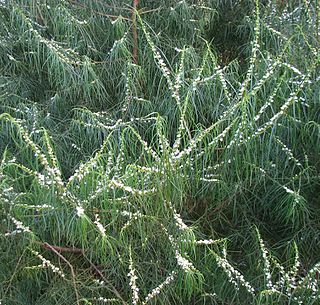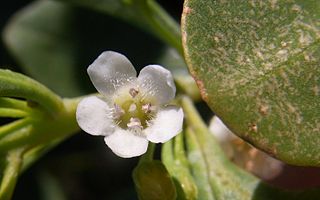
Myoporum laetum, commonly known as ngaio or mousehole tree, is a species of flowering plant in the family Scrophulariaceae and is endemic to New Zealand. It is a fast growing shrub or small tree with lance-shaped leaves, the edges with small serrations, and white flowers with small purple spots and 4 stamens.

Myoporum rapense is a plant in the figwort family, Scrophulariaceae and is endemic to French Polynesia and the Kermadec Islands. It is closely related to Myoporum laetum and there are two subspecies which are found on different island groups.
Myoporum stokesii is a plant in the figwort family, Scrophulariaceae and is endemic to the island of Raivavae in French Polynesia. It is similar to the two other members of its genus on the island, Myoporum rapense and Myoporum rimatarense although the former has serrated leaves and the latter has wider leaves and differently shaped fruits.

Myoporum sandwicense, commonly known as naio, bastard sandalwood or false sandalwood is a species of flowering plant in the figwort family, Scrophulariaceae. It is a tree or shrub highly variable in its form, the size and shape of its leaves, in the number of flowers in a group and in the shape of its fruit. It is endemic to Hawaiʻi.

Myoporum parvifolium, commonly known as creeping boobialla, creeping myoporum, dwarf native myrtle or small leaved myoporum is a plant in the figwort family, Scrophulariaceae. It is a low, spreading shrub with long, trailing stems and white, star-shaped flowers and is endemic to southern Australia including Flinders Island.

Myoporum viscosum, commonly known as sticky boobialla, is a plant in the figwort family, Scrophulariaceae and is endemic to South Australia. It is unusual in that sometimes, especially when the leaves are crushed, it has an extremely unpleasant smell.

Myoporum petiolatum, commonly known as sticky boobialla, is a plant in the figwort family Scrophulariaceae, and is endemic to the south-east of continental Australia. For many years this species has been confused with the much less common species Myoporum viscosum from which it can be distinguished by its thinner, noticeably petiolate and non-odorous leaves.

Myoporum floribundum, commonly known as weeping myoporum or slender myoporum, is a sour-smelling glabrous shrub in the family Scrophulariaceae endemic to a small area of New South Wales and Victoria in Australia. It has long, thin, drooping leaves and profuse white flowers in clusters along the stems in spring. Although it is uncommon in nature, it has long been available as a popular garden plant.

Myoporum montanum, commonly known as waterbush or boobialla, is a shrub native to Australia, New Guinea and Timor. The species is extremely variable in size growth habit and leaf form, with three primary forms recognised. Its occurrence in many places is restricted to coastal regions, watercourses and other locales with more reliable water supplies. It was this association with water that gave rise to the name water bush.

Myoporum boninense is a plant in the figwort family, Scrophulariaceae. It is a shrub with thick, fleshy, glossy leaves, white flowers in small groups and shiny lilac to pale purple fruits. It grows in coastal heath in New South Wales and Queensland in Australia and on islands in the north west Pacific Ocean.
Myoporum crassifolium is a plant in the figwort family, Scrophulariaceae. It is a shrub or small tree with thick, fleshy leaves and small groups of white flowers spotted with pink or purple. It is endemic to New Caledonia, Vanuatu and the Loyalty Islands and is a rich source of the essential oil, bisabolol.

Myoporum mauritianum is a flowering plant in the figwort family Scrophulariaceae and is endemic to a few volcanic islands in the Indian Ocean. It is a small, low-branched shrub with serrated leaves and small white flowers and usually grows on calcarenite within 20 metres (70 ft) of the sea.

Myoporum obscurum, commonly known as popwood, sandalwood or bastard ironwood is a plant in the figwort family, Scrophulariaceae. It is a very rare shrub, endemic to Norfolk Island where it occurs in a few scattered locations.

Myoporum oppositifolium, commonly known as twin-leaf myoporum, is a plant in the figwort family, Scrophulariaceae. It is easily distinguished from others in the genus by the combination of glabrous leaves and branches, its opposite leaf arrangement and its serrated leaves. Its distribution is restricted to the extreme south-west of Western Australia.

Myoporum platycarpum, known by several common names including sugarwood, false sandalwood and ngural is a plant in the figwort family, Scrophulariaceae. It is rounded with bright green foliage as a young shrub and roughly fissured, dark grey bark when mature. Sugarwood is endemic to the southern half of continental Australia.

Myoporum tetrandrum, commonly known as slender myoporum or boobialla is a plant in the figwort family, Scrophulariaceae. It is an erect and spreading shrub endemic to the south-west of Western Australia, common in moist areas and like most of the other members of its genus has bell shaped, star-like white flowers in the leaf axils.

Myoporum turbinatum, commonly known as salt myoporum, is a plant in the figwort family, Scrophulariaceae and is endemic to a small area near Esperance in Western Australia. It is closely related to Myoporum platycarpum but has much narrower leaves and differently shaped fruit. Its sticky branches and narrow, warty leaves are distinctive.

Myoporum velutinum is a plant in the figwort family, Scrophulariaceae and is endemic to a small area near Esperance in Western Australia. It has similar flowers and fruits and grows in similar environments to Myoporum tetrandrum but differs from it and all other members of the genus by having hairs on the outer edge of the petals.

Myoporum bontioides is a species of the flowering plant in the family Scrophulariaceae. It is a shrub growing in coastal areas of southern Japan and South China including beaches and estuaries where there are no large breaking waves.

Geniostoma sykesii is a species of flowering plant in the family Loganiaceae, endemic to the islands of Mangaia and Mitiaro in the Cook Islands. It grows on makatea terrain. Its dried leaves are used in ‘ei, and used to scent multiple products.



















